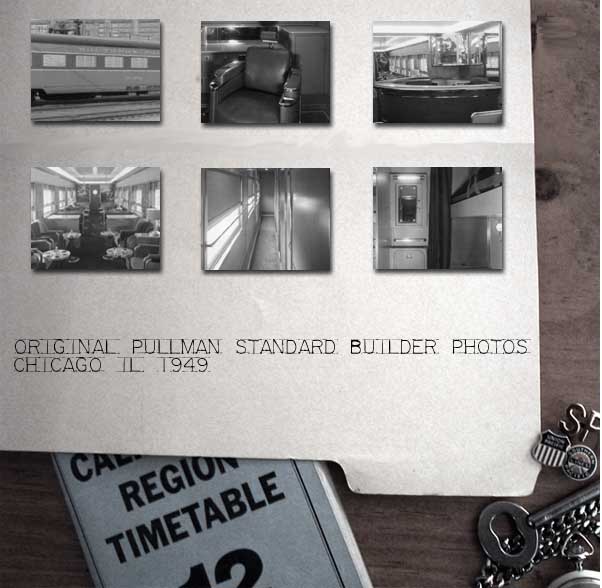




... of the Overland Trail (well, it use to be brief) former Southern Pacific club lounge 2981. We'll also include some thoughts and history regarding the San Francisco Overland, the barbershop and stewardess functions on the Overland Trail ... as well as similar services offered by other railroads. Plus, we'll include interesting information from the cars "modern history" ... while the car has been under the care of the Hatrick family. After all, the Hatricks have owned the car nearly as long as SP had it! (Southern Pacific owned the car for 24 years, the Hatrick's have owned the car for 22 years ... as of 2009 ... and counting)


The Overland Trail is a 39 seat Club Lounge with Barbershop and Shower. It was built by the Pullman Standard Car Manufacturing Company for delivery to the Southern Pacific Railroad in December of 1949. Numbered SP 2981, the car was specifically ordered in October of '47 for the San Francisco Overland, a train jointly operated by the Southern Pacific, Union Pacific, and the Chicago & North Western railroads between Chicago, IL and Oakland, (San Francisco) CA.
One of six sisters (built to Lot 6806, Plan 7580), cars 2981, 2982, and 2983 were assigned to the San Francisco Overland, while cars 2984 and 2985 (ordered June '46) were assigned to the Golden State. Car 2986 (ordered August 47) found itself assigned to the City of San Francisco. This car order (Lot 6806, which included cars of many different configurations) was actually part of a larger order of lot numbers 6805, 6815 and 6816. Between 1946 and 1954, the Southern Pacific purchased 261 new passenger cars at a cost of $48 million dollars (the Overland Trail cost approximately $200,000 when built). In 1949 and 1950 the Southern Pacific placed more new streamlined cars into service than any other two year period in the company's history. In 1950 alone, 119 new cars were placed in service.
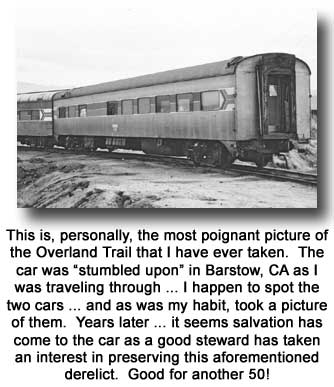
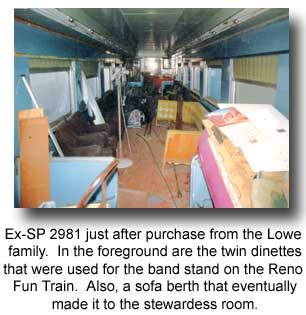
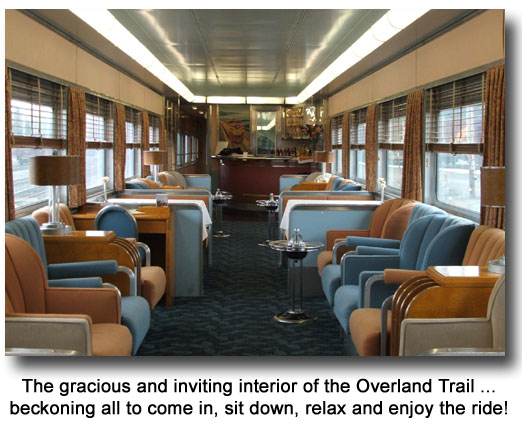
All aboard for Anaheim, Azusa and Cucamonga! Return with us now to those thrilling days of yesteryear as Bill and Debbie turn back the clock enroute aboard their classic train car, Overland Trail! Train travel was not just a means of traveling from one city to another, it was part of the journey's experience. Getting there truly was half the fun.
Welcome aboard the Overland and Amber Trail! Whether you're an armchair adventurer exploring by Internet or a seasoned rail traveler, you'll enjoy learning about the postwar streamliner era through this website and possibly ... by joining us for a ride aboard these magnificent examples of the car builders craft. Bill and Debbie have spent more than a decade restoring both cars and are pleased to offer them as living history artifacts of the great streamliner era!
The Overland Trail is the former Southern Pacific 2981, a club-lounge car, built in 1949 by the Pullman Standard Car Manufacturing Company. The Amber Trail is the former Union Pacific 5430, a 44 seat transcontinental chair car, built in 1950 by Pullman as well.
Bill and Debbie bought their first car in 1983 and now are veterans of private railcar operation. (In fact, they have now owned their ex Union Pacific coach LONGER then UP had it!). Riding one of their vintage railcars is a unique experience, harkening back to the golden age of streamliner travel.
Our public excursions are perfect for individuals and small groups. Larger groups and corporate customers may charter their own private excursions. Either way, you'll find that, in the words of Eleanor R. Belmont, wife of industrialist August Belmont, "private rail cars are not an acquired taste ... one takes to it immediately!"
Between runs, the Overland Trail is berthed at Union Station in Los Angeles, California. We are always happy to show the car to customers and visitors alike. Please call to arrange a tour.

The Southern Pacific, along with many other major railroads, anticipated delivery of their cars right after the war ... they were eager to re-equip their worn out equipment after tremendous overuse during W.W.II. However, the demand for consumer goods, combined with continued post war material shortages, and rail car manufactures giving precedence to freight car orders, delayed delivery of passenger cars for several years.
Southern Pacific club-lounge 2981, the first of the six barbershop lounges, was outshopped from the Pullman plant in Chicago, Ill. in December of 1949. The lounge car was a standard 85 foot long car measuring 10 feet wide and 13'6" tall. It was delivered in an elegant two-tone gray paint scheme (with white stripes separating the grays).
The interior features a stunning Streamline Moderne 39 seat main salon with 16 seats at 4 tables with the balance of the seating made up of loose club chairs.
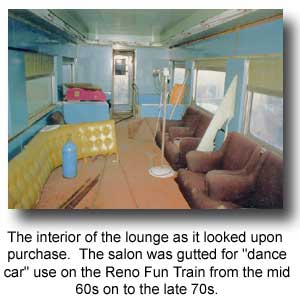
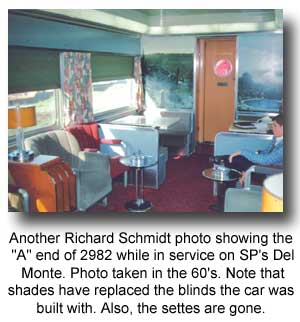
As stated, the 2981, 2982, 2983 and 2986 were originally assigned to the "Overland Route" which was the path of the original, historic transcontinental railroad. The transcontinental railroad was a joint project by SP predecessor Central Pacific which built from Sacramento, California east, and the Union Pacific Railroad which built west from Omaha, Nebraska. This route was completed joining east and west with the historic driving of the golden spike at Promontory, Utah on May 10, 1869. The third member of the "Overland Route" was the Chicago and Northwestern filling the gap between Omaha and Chicago. This total route covered 1,780 miles from Chicago to Oakland.
To elaborate on the joint operation, the San Francisco Overland was operated by the Southern Pacific from San Francisco/Oakland to Ogden Utah.
The train was operated by the Union Pacific Railroad from Ogden to Omaha. The Chicago & Northwestern Railroad handled the final leg of service from Omaha to Chicago (the Milwaukee Road handled C&NW's portion from the mid 1950's to the Amtrak era). By September of 1950, the timetable shows train number 27, the west bound San Francisco Overland leaving Chicago at 8:00 PM daily, and arriving in San Francisco 48 hours and 55 minutes later at 6:55 PM. The final 35-minute leg of the journey from Oakland Pier to San Francisco was by the Southern Pacific Ferry. After a sixteen hour layover, the counter part, train number 28, would depart San Francisco at 11:00 AM and arrive in Chicago at 1:00 PM two days later. A section of the San Francisco Overland would continue from Ogden to Denver, Kansas City and St. Louis.
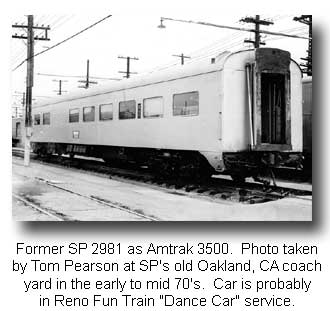
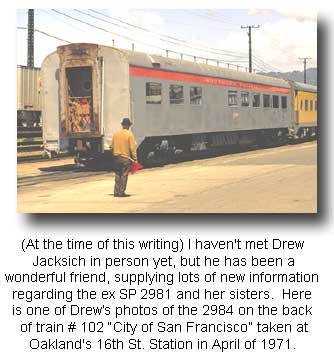
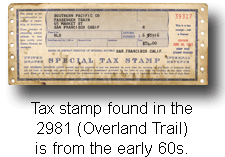

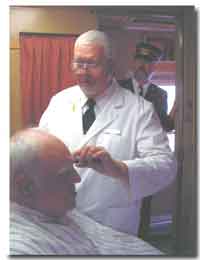
The Overland Trail is equipped with (what is thought to be) the sole operating streamliner era railroad barbershop in the world. Once a common feature aboard the premier trains of old ... the railroad barbershop succumbed to the realities of the jet age in the mid 50s. The honor of carrying the last barbershop probably falls to the famous Super Chief, flagship of the former Atchison, Topeka and Santa Fe Railway. The train, affectionately known as "The Train to the Stars", because of its Hollywood celebrity patrons, lost several premium services on January 10th 1954 including the barbershop.
Before the jetage, the business traveler made up a very important percentage of the railroads ridership ... and they needed to arrive at their destination clean, well groomed and "dapper", if they wanted to "make that sale". The onboard barbershop made all that possible as quite typically, the barber not only provided the tonsorial arts at speed, but also presided over a shower bath and cloths pressing services as well. Indeed, the Overland Trail sports a quite substantial 32 volt "American Beauty" pressing iron. An annex off of the barbershop provides a complete public shower with all of the amenities ... toilet, vanity mirror, clothes locker, sink and of course, a spacious "monel metal" lined shower.
In this new millennium, the barbershop elicits "dropped jaws of unbelief" as visitors and patrons pass down the hall way and spy the barbershop! If underway during one of our frequent public "day trips" out of Los Angeles (or the occasional steam special anywhere around the western USA), chances are good that you'll find our stalwart barber extraordinare, Earl Nickles manning the shop and providing that time honored tradition ... the tonsorial arts at speed, while transverseing the silvery rails from city to city.
I met Earl at the Orange Empire Railway Museum in the mid 80s. I found out that we shared similar railroad and spiritual passions ... and I found out one thing more ... he was a barber by trade! At the time, I was nearing completion of the lounge car (at least enough to operate) and had our maiden voyage looming (as part of the train that would be pulled by the magnificent and beautifully restored, 1927 built, ex-AT&SF steam locomotive, 3751 ... also making its public "maiden run"). Naturally, I had to have a barber aboard for this extraordinary journey (from LA to Barstow to Bakersfield and return) and hoped that Earl would be interested in a "busman's holiday". Although Earl was beside himself with the prospect of "cutting hair at speed", unfortunately, he was unable to "open the shop" on the Overland's first outing as a full-fledged barbershop lounge car in decades.
Debbie's childhood friend, Eugenie Quintal had a brother in law who cut hair, John Dematos (affectionately known as "John the barber" to the Hatricks). It was John who made the maiden voyage with us and resurrected a dead tradition in grand style ... behind a steam locomotive in December of 1991.
Earl has been THE barber of the Overland Trail, but other barbers have had a chance to helm the last operating barbershop: Sandy in Oregon has made three trips, Lee Weaver several trips, with cameos by John Dematos, Doyle Henderson, Ed Holt and C. Ford Haskel.
Some have said (my thoughts as well), that the barber's chair is the "best seat in the house" I'm closing in on 50 haircuts. Sorry, ... doubt that anybody in the world will ever break my record in the Guinness category of "hair cuts in moving railway car".

Stewardess Room: The Overland Trail was built with a special double bedroom that was originally designated as the quarters for the stewardess/nurse assigned to the San Francisco Overland.
The physical bedroom quarters on board the Overland: Although the car was built after the war, the room is typical of prewar construction -- that is, the sink and toilet are in the same room as the bed. Most post war cars featured a toilet annex in each multi-bed room that helped ease the awkwardness of using the facilities while the room was occupied by your travelling companion. The room was designed with the very popular "full width" (perpendicular to the length of the car) lower sofa berth (which folded down for night use) plus the upper which folded away into the upper wall when not needed.
"YOU sir / madam, are you next? Please have a seat"